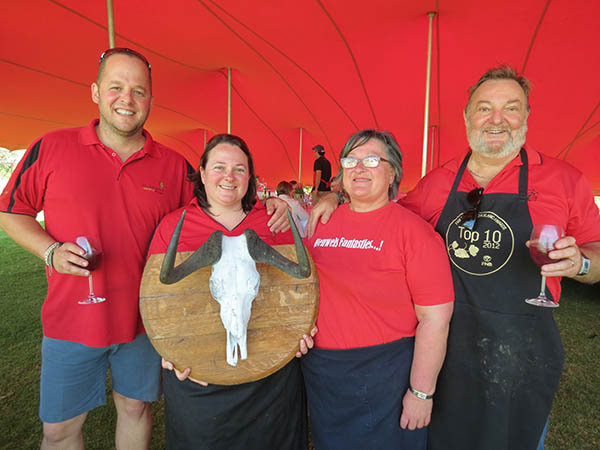Not all paellas are equal, as the newly crowned champions of the fifth annual friendly cook-off between the Muratie and Du Toitskloof wineries proved again earlier this week. With the venue alternating each year, Du Toitskloof Wines just outside Worcester made good use of their home ground advantage and claimed the title this year from a panel of foodies that included SA celebrity chef Pete Goffe-Wood.
Said to have originated in the Spanish city of Valencia, paella has evolved into many different variations with the base ingredients being rice and vegetables. ‘Most importantly, a paella is never stirred,’ Pete says of the dish that’s traditionally prepared in a large flat pan. ‘The secret is to create an underlying crust, achieved best when cooking on a fire. But remember there’s a very fine line between crust and burnt.’

Du Toitskloof’s winning paella was created by first lightly frying up some chopped vegetables then adding risotto, spiced with saffron and seasoning. Stock was added periodically as the rice absorbed the liquid. Prawns, crayfish and calamari were cooked separately then added to the main dish along with choriso. The key ingredient to a great paella is the stock, claims Du Toitskloof Wines’ chef-for-the-day Muller Coetzee, who used home-made chicken and crayfish stock for the dish. Here, he gives us a step-by-step to making your own:
1 Collect the leftovers from a crayfish meal, such as the shell and bits of leftover fleshCrush it using a mortar and pestle, cover with water and allow to simmer gently for at least three hours, making sure it doesn’t cook dry. Strain out the liquid stock with a muslin cloth, bottle it, allow to cool and store in the fridge.
2 Crush all the leftovers using a mortar and pestlecover with water and allow to simmer gently for at least three hours, making sure it doesn’t cook dry. Strain out the liquid stock with a muslin cloth, bottle it, allow to cool and store in the fridge.
3 Add to a pot, cover with water and allow to simmer gently for at least three hours, making sure it doesn’t cook dry
4 Strain out the liquid stock with a muslin cloth, bottle it and allow to cool. Your stock can be stored in the fridge.
Photography Clifford Roberts, foodiesfeed.com


What a crime!!! Paella NEVER NEVER NEVER has chorizo!!
Chorizo is forbidden in the paella. Disgusting. https://www.theguardian.com/world/2016/oct/04/jamie-olivers-paella-chorizo-brings-fractured-spain-together-against-him?CMP=twt_gu
If there is NO Chorizo and Saffron!
It’s not Paella!
People tend to forget that this dish like many others in many other countries was a peasant dish. People put what they had or could easily get in a pot and cooked it. So do not tell me that if oil ran low they cannot use chorizo which contains fats and oils. Modern chefs should experience a war and comment maybe? Love chorizo in my paella and so does everyone else that ate my paella. Oh,…..and by the way some people prefer the slightly burnt rice crust at the bottom of the pan as it is infused with all the juices of the “stuff” that went into the pan. Mouthwatering.
Have U been to Spain where this dish Originated?!
I’m from Spain.
If there is chorizo, It’s just rice with chorizo. Not paella, a recipe from Spain where never, never use “chorizo” to cook it.
Una buena paella española Barcelona ☺️?